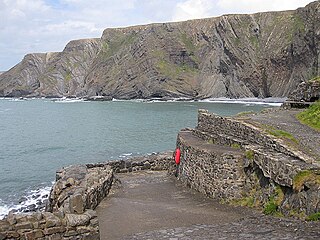
Robert Stephen Hawker (1803–1875) was a British Anglican priest, poet, antiquarian and reputed eccentric, known to his parishioners as Parson Hawker. He is best known as the writer of "The Song of the Western Men" with its chorus line of "And shall Trelawny die? / Here's twenty thousand Cornish men / will know the reason why!", which he published anonymously in 1825. His name became known after Charles Dickens acknowledged his authorship of "The Song of the Western Men" in the serial magazine Household Words.

Morwenstow is a civil parish in north Cornwall, England, United Kingdom. The parish abuts the west coast, about six miles (10 km) north of Bude and within the Cornwall Area of Outstanding Natural Beauty (AONB).

The Manacles are a set of treacherous rocks off The Lizard peninsula in Cornwall. The rocks are rich in marine wildlife and they are a popular spot for diving due to the many shipwrecks. Traditionally pronounced mean-a'klz (1808), the name derives from the Cornish meyn eglos, the top of St Keverne church spire being visible from the area.

Hawker's Hut is an historic hut at Morwenstow, Cornwall originally built by the eccentric clergyman, poet and antiquarian, Robert Stephen Hawker, close to Higher Sharpnose Point. The hut is located approximately 1 mile from Morwenstow Church.

HMS Anson was a ship of the Royal Navy, launched at Plymouth on 4 September 1781. Originally a 64-gun third rate ship of the line, she fought at the Battle of the Saintes.

The Church of St Morwenna and St John the Baptist is the parish church of Morwenstow, north Cornwall, England, United Kingdom, the most northerly parish in Cornwall. The church is dedicated to Morwenna, a local saint, and to John the Baptist, and is recorded in the National Heritage List for England as a designated Grade I listed building. It is an active Anglican parish church in the diocese of Truro, the archdeaconry of Bodmin, and the deanery of Stratton. Its benefice is combined with that of St James, Kilkhampton to form the United Benefice of Kilkhampton with Morwenstow.
Duke of York was a three-masted brig launched in 1817 at Bideford as a Falmouth packet, sailing between Falmouth, Cornwall, and Jamaica. In 1836 she brought settlers to South Australia for the South Australia Company. She was wrecked in 1837.
The Derry Castle was a 1,367 ton iron barque built at Glasgow in 1883, and initially operating out of Limerick, Ireland. She had been registered there on 19 November 1883 by Francis Spaight & Sons. In 1887 while voyaging from Australia to the United Kingdom with a cargo of wheat, she foundered off Enderby Island, in the subantarctic Auckland Islands, on a reef which now bears her name.

Hartland Quay is located on the Atlantic coast of Devon, England, south of Hartland Point and north of Bude, Cornwall. It experiences some of the roughest seas in winter and is a former harbour.
HMS Royal Anne Galley was a 42-gun fifth-rate frigate of the Royal Navy. She ran aground and was wrecked during a gale off Lizard Point, Cornwall, while she was travelling to the West Indies. The wreck is a Protected Wreck managed by Historic England.
Sarah Anderson was a British barque built in Liverpool in 1865. The ship was wrecked on 17 October 1886 en route from Coquimbo, Chile to Fleetwood, Lancashire when it ran aground on rocks near Trebarwith Strand, Cornwall.







